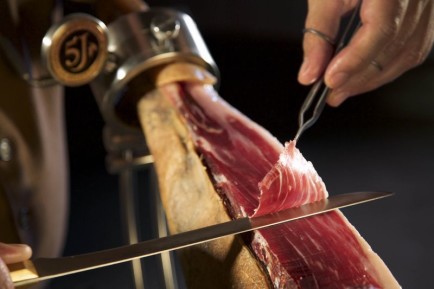
China now has a ham-slicing school and is driving surging demand for Spanish jamón.
China’s growing love affair with all things Spain-related is something that is to be welcomed, on the whole.
A growing interest among Chinese tourists in Spanish cities such as Seville, Málaga and Madrid means a certain spending boom, while a developing taste for Spanish wine and olives is helping to boost these industries’ global profits…
But could China’s newly discovered love of dry-cured jamón ibérico be causing devastating shortages of the beloved ham across Spain? According to the head of Cinco Jotas, the most world-renowned brand of jamón, recent lifting of restrictions in importing such foodstuffs into China has caused a surge in demand – leaving some suppliers worried that they might not be able to meet domestic desires this Christmas.
What’s more, as demand has now begun to outstrip supply, jamon producers have increased their prices: El País is reporting that a 7.5kg leg is now retailing for as much as €600, representing a price increase in excess of 20%.
Specifically, the Chinese market is after jamón ibérico de bellota, which is acorn-fed ham produced using Iberian blackfoot pigs. Their meat is considered such a delicacy because the pigs spend several months of the year roaming oak-lined pastures feeding on grass and the acorns that fall. This diet gives the pigs’ flesh its unique flavour – a flavour that has tickled the tastebuds from Shanghai to Beijing.
“It’s inevitable that the price in Spain is going to rise,” said Roberto Batres, director of Shanghai de Delaiberia Gold, which exports the ham, along with Spanish wine and olive oil, to China. “The companies licensed to trade in China don’t have enough jamón de bellota to meet Chinese demand.”
It’s not just the flavour that has seduced the Chinese. Among the growing middle class, status is everything, so the sight of a long leg, bolted to a traditional frame and expertly sliced by a typical narrow blade is the party trick du jour for a growing army of Chinese households, Batres added.
“They have established a ham-cutting school in China and a professional association,” he said. “That’s a sign of how far the product has penetrated the local market.”
 en
en



 Vlaams-Nederlands
Vlaams-Nederlands
0 Comments
Leave a Comment
DISCLAIMER
The opinions and comments expressed by contributors to this Blog are theirs alone and do not necessarily reflect the views of VIVA Homes Under the Sun Ltd, any of its associated companies, or employees; nor is VIVA to be held responsible or accountable for the accuracy of any of the information supplied.
Have you got something to say?